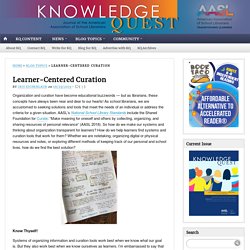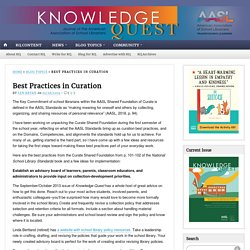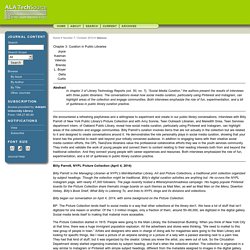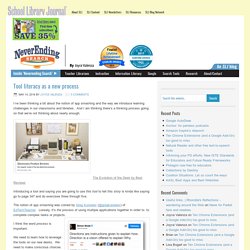

*OER and you. The curation mandate. At the #GoOpen Exchange on Friday, everyone was talking about OER and the need to curate.

The Twiter feed shows the buzz around the trending event and it shows school librarians were at the table. As the initiative moves forward, it is critical for us to choose to be at the head of this particular table. Hosted at the beautiful Skywalker Ranch, Friday’s #GoOpen Exchange engaged major players in education from the White House and the DOE, as well as state officials, leaders of non-profits and learning institutions, the biggest names in e-commerce and technology, developers, vendors, publishers, state officials, administrators, leading folks in edtech, and educational thinkers and practitioners. I was proud to be there to share along with some serious library power: AASL President Leslie Preddy, Mark Ray (WA) Washington, Jennifer Boudrye (D.C.) and Mary Reiman (NE). *Learner-Centered Curation. Organization and curation have become educational buzzwords — but as librarians, these concepts have always been near and dear to our hearts!

As school librarians, we are accustomed to seeking solutions and tools that meet the needs of an individual or address the criteria for a given situation. AASL’s National School Library Standards include the Shared Foundation for Curate: “Make meaning for oneself and others by collecting, organizing, and sharing resources of personal relevance” (AASL 2018). So how do we make our systems and thinking about organization transparent for learners? How do we help learners find systems and curation tools that work for them? * Are You a Curator or a Dumper? *Best Practices in Curation. The Key Commitment of school librarians within the AASL Shared Foundation of Curate is defined in the AASL Standards as “making meaning for oneself and others by collecting, organizing, and sharing resources of personal relevance” (AASL, 2018, p. 94).

I have been working on unpacking the Curate Shared Foundation during the first semester of the school year, reflecting on what the AASL Standards bring up as curation best practices, and on the Domains, Competencies, and alignments the standards hold up for us to achieve. For many of us, getting started is the hard part, so I have come up with a few ideas and resources for taking the first steps toward making these best practices part of your everyday work. Here are the best practices from the Curate Shared Foundation from p. 101-102 of the National School Library Standards book and a few ideas for implementation: The September/October 2013 issue of Knowledge Quest has a whole host of great advice on how to get this done. Work Cited. *Librarians as Social Media Curators. *Curation Situations: Let us count the ways. Curation is a funny word.

When my colleagues and I wrote our Social Media Curation Library Technology Report for ALA, we struggled with a definition. The folks we interviewed across library land curated in several different ways and we used the term curation differently depending on current community needs or where they were in any particular project. *Getting Started with Content Curation in the Classroom. HyperDocs and the teacher librarian. The concept of HyperDocs is spreading all over edtech land.

HyperDocs are perfect opportunities to grow teacher librarian/ classroom teacher partnerships. A true extension of what TLs do or should be doing in a hyperlinked information landscape, HyperDocs are all about curation and collaboration, instruction based on engaged inquiry, as well as our mission to inspire learning communities to think, create, share and grow. While it’s quite possible you’ve been building HyperDocs-like instruction for years on a variety of platforms, we can now connect our work to an accepted model and a growing and generous community!
What are HyperDocs? Chapter 9: Conclusion: Issues and Trends. Should we accept them, librarians have unlimited opportunities for leadership in social media curation, functioning as guides, information brokers, interpreters, storytellers, innovators, teachers, marketers, networkers, and connectors.

What Maria Popova calls “an increasingly valuable form of creative and intellectual labor, a form of authorship” is an area we cannot ignore. In our areas of expertise, for users we know so well, we should not be abdicating these activities to others. Chapter 4: Curation in School Libraries. The school librarians featured in this chapter describe the value of curation to a school’s learning culture.

Their efforts ensure that their investment in e-books, databases, and homegrown instructional content is scaled, embedded, and discoverable whenever students need it. Their efforts support flipped and hybrid learning. They use new strategies to display and juxtapose books and other media face-out in imaginative genre gatherings perhaps never before physically arranged. Most important, the school librarians we spoke with shared the importance of curation as a learning activity. They described helping learners connect more easily with appropriate resources and saving teachers instructional time. Curation for Students Shannon McClintock Miller, Van Meter (IA) School (May 22, 2014) Chapter 3: Curation in Public Libraries. We encountered a refreshing playfulness and a willingness to experiment and create in our public library conversations.

Interviews with Billy Parrott of New York Public Library’s Picture Collection and with Amy Sonnie, Teen Outreach Librarian, and Meredith Sires, Teen Services department intern, of Oakland Public Library, reveal how social media curation, particularly using Pinterest and Instagram, can highlight areas of the collection and engage communities. Billy Parrott’s curation involves items that are not actually in the collection but are related to it and designed to create conversations around it. He demonstrates the role personality plays in social media curation, showing that your brand has the potential to reach well beyond your initially conceived audience. In addition to engaging teens with their creative social media curation efforts, the OPL TeenZone librarians value the professional collaborative efforts they see in the youth services community.
BP: Do what you love. Curation Situations: Let us count the ways. Curation (song parody) Tool literacy as a new process. I’ve been thinking a bit about the notion of app smashing and the way we introduce learning challenges in our classrooms and libraries.

And I am thinking there’s a thinking process going on that we’re not thinking about nearly enough. The Evolution of the Desk by Best Reviews Introducing a tool and saying you are going to use this tool to tell this story is kinda like saying go to page 347 and do exercises three through five. The notion of app smashing was coined by Greg Kulowiec (@gregkulowiec) of EdTechTeacher Loosely, it’s the process of using multiple applications together in order to to complete complex tasks or projects.
I think the word process is important. We need to learn how to leverage the tools on our new desks. Affordances are the possible ways a tools could be used by an individual in a particular context. I’ve been engaging in a bit of metaphorical thinking around tool literacy: It’s a bit like building a piña colada out of Jelly Belly jelly beans. Collections by Destiny. The 5 Models Of Content Curation. Curation has always been an underrated form of creation.

The Getty Center in Los Angeles is one of the most frequently visited museums in America – and started as a private art collection from one man (J. Paul Getty) who had a passion for art. Aside from a few well known examples like this one, however, the term curation has rarely been used outside of the world of art … until now. One of the hottest trends in social media right now is content curation – thanks in no small part to the leading efforts of several thought leaders actively promoting the idea. Joe Pulizzi is a “content marketing evangelist” who speaks and writes often about content marketing publishes a list of the best content marketing blogs across the web. What Is Content Curation?